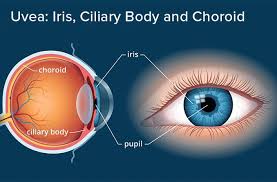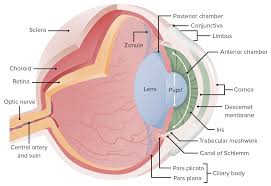
 Also called the uveal layer, uveal coat, uveal tract, vascular tunic or vascular layer is the pigmented middle of the three concentric layers that make up an eye.
Also called the uveal layer, uveal coat, uveal tract, vascular tunic or vascular layer is the pigmented middle of the three concentric layers that make up an eye.
The uvea consists of the: iris, ciliary body and choroid.
It is the vascular middle layer of the eye.
It is divided into three areas, from front to back, the:
Iris
Ciliary body
Choroid
The functions of the uveal tract as a unit are:
Nutrition and gas exchange to the outer retina, sclera, and lens, which lack any intrinsic blood supply.
Light absorption: the uvea improves the contrast of the retinal image by reducing reflected light within the eye, and also absorbs outside light transmitted through the sclera, which is not fully opaque.
Secretion of the aqueous humour by the ciliary body, control of accommodation by the ciliary body, and optimization of retinal illumination by the iris’s control over the pupil.
